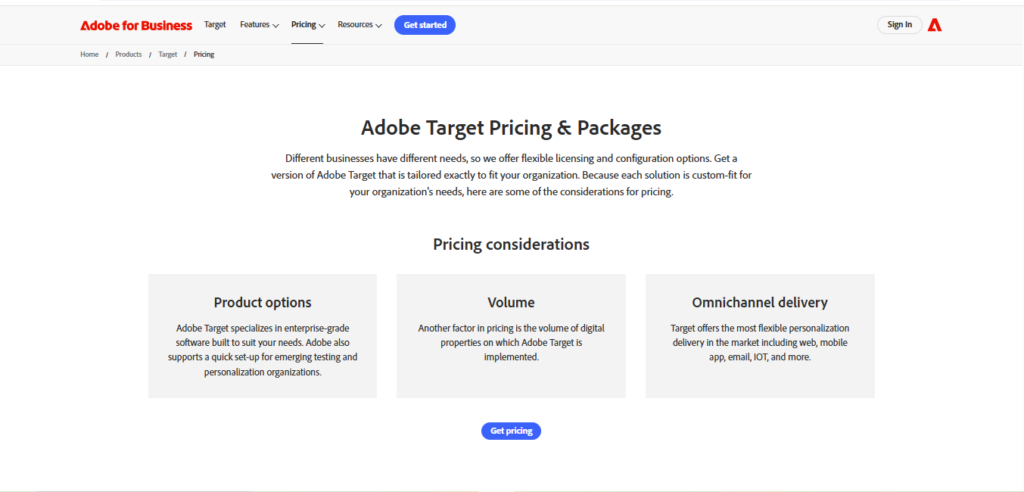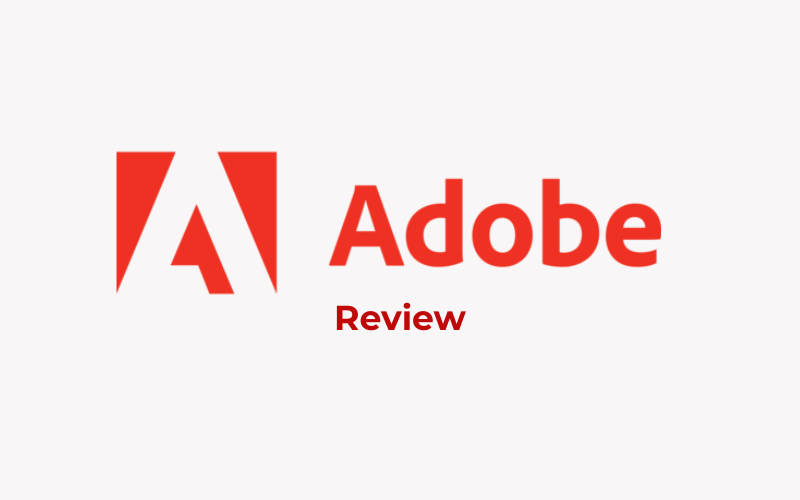What is Adobe Target?
Adobe Target is a powerful tool designed for businesses looking to optimize and personalize digital experiences at scale. Whether you’re running A/B tests, delivering tailored content, or analyzing customer behavior, Adobe Target provides a comprehensive suite of features to enhance user engagement. In this blog post, we’ll dive deep into Adobe Target reviews, its pricing, how it works, and how it compares to its competitors, helping you decide if it’s the right fit for your business.
Ease of Use
When evaluating any digital experience platform, ease of use is a major consideration—especially for teams without deep technical expertise. So how does Adobe Target perform in this area?
User Interface and Navigation
Adobe Target offers a clean, professional interface that integrates well with other Adobe Experience Cloud tools. The dashboard is structured and organized, allowing users to access testing, targeting, and reporting features easily. However, for first-time users, the interface may feel overwhelming due to the wide range of options and features.
Learning Curve
Adobe Target is built for enterprise users, which means it comes with a steeper learning curve compared to simpler A/B testing tools. While marketers can handle basic functions, more advanced setups (like multivariate testing or auto-targeting) may require the help of developers or analysts.
Built-in Templates and Guided Workflows
To make things easier, Adobe Target includes pre-built templates and guided workflows. These help users launch experiments faster without starting from scratch. The guided steps are especially useful for users who are new to testing and personalization.
Integration with Adobe Experience Cloud
One of the biggest advantages is how seamlessly Adobe Target integrates with other Adobe tools like Adobe Analytics. This makes the overall workflow more efficient, especially for teams already using Adobe’s ecosystem.
Support and Documentation
Adobe provides extensive documentation, training videos, and a community forum to help users get started and troubleshoot issues. For enterprise customers, premium support is also available.
Adobe Target Pricing
Adobe Target uses a custom pricing model, which means there’s no publicly listed price on its website. Instead, Adobe tailors the cost based on your business size, traffic volume, and specific feature needs.
Businesses interested in Adobe Target need to contact Adobe’s sales team to get a personalized quote. The final cost typically depends on factors such as the amount of website traffic, how many monthly visitors or impressions you receive, the features you want to use (like A/B testing or AI personalization), and whether you’re integrating it with other Adobe products.
Since Adobe Target is part of the Adobe Experience Cloud, it’s primarily designed for medium to large businesses. As a result, pricing tends to be higher than many standalone A/B testing tools and may not be ideal for smaller companies or startups with limited budgets.
In some cases, Adobe Target can be bundled with other Adobe Experience Cloud products like Adobe Analytics or Adobe Experience Manager. This bundling can influence the pricing structure and potentially offer better value for businesses already using Adobe’s ecosystem.
While Adobe Target doesn’t offer standard pricing plans, it provides flexibility and scalability tailored to enterprise-level needs. It’s a premium solution best suited for organizations that require robust testing and personalization capabilities.

Key Features of Adobe Target
Adobe Target is a powerful tool designed to help businesses optimize their digital experiences through testing, targeting, and personalization. Here are the key features that make Adobe Target stand out:
1. A/B Testing
Adobe Target allows you to run A/B tests to compare different versions of your website or app content. You can test headlines, images, buttons, and layouts to see what performs best with your audience.
2. Multivariate Testing
Unlike simple A/B testing, multivariate testing lets you test multiple elements on a page simultaneously. Adobe Target helps you identify which combination of elements has the highest impact on user behavior.
3. AI-Powered Personalization (Adobe Sensei)
Adobe Target uses Adobe Sensei, its built-in AI engine, to deliver personalized content based on user behavior, location, device, and more. This helps improve engagement and conversion rates.
4. Auto-Targeting
Auto-Targeting uses machine learning to automatically deliver the most relevant experience to each visitor. It continuously learns from user interactions and adapts to improve performance over time.
5. Rules-Based Targeting
With Adobe Target, marketers can set up audience segments using predefined rules. You can target users based on factors like location, device type, browser, traffic source, or previous behavior.
6. Experience Targeting (XT)
This feature lets you manually create and deliver specific experiences to different audience segments. It’s ideal when you want full control over who sees what content.
7. Recommendations Engine
Adobe Target offers a product recommendation engine that suggests items based on customer behavior, best sellers, or custom logic. It’s especially useful for ecommerce businesses looking to increase average order value.
8. Mobile App Optimization
Adobe Target isn’t limited to websites. You can also run tests and deliver personalized experiences in mobile apps, ensuring a consistent experience across platforms.
9. Integration with Adobe Experience Cloud
Adobe Target integrates seamlessly with other Adobe products like Adobe Analytics and Adobe Experience Manager. This helps unify data and improves campaign efficiency.
How Adobe Target Works
Adobe Target is designed to help businesses test, personalize, and optimize digital experiences across websites, apps, and other customer touchpoints. It works by combining data-driven targeting with automation and artificial intelligence to deliver the most relevant content to each user.
Setting Up Experiments
Users begin by creating A/B tests or multivariate tests within the Adobe Target interface. You can define what elements you want to test—like headlines, images, or call-to-action buttons—and set goals such as increasing clicks, conversions, or time on site.
Audience Targeting
Next, you define the audience segments. These can be based on user behavior, location, device type, referral source, or even past purchase activity. Adobe Target then ensures each user sees the version of the experience that’s most relevant to them.
Automated Personalization
Using Adobe Sensei, Adobe’s AI engine, Adobe Target automatically analyzes performance data in real-time. It adjusts which content is shown to which users, learning and improving as more data is collected. This allows businesses to deliver highly personalized experiences at scale.
Integrating with Other Tools
Adobe Target works best when integrated with other tools in the Adobe Experience Cloud, such as Adobe Analytics. These integrations enable richer insights and more precise targeting based on deeper customer data.
In short, Adobe Target works by allowing you to test different experiences, target specific audience segments, and use AI to deliver personalized content that performs better. The process is both strategic and automated, making it ideal for businesses focused on optimizing digital performance.
Adobe Target vs Competitors
When it comes to testing and personalization tools, Adobe Target competes with several platforms like Optimizely, VWO, Google Optimize (now sunset), and Dynamic Yield. Each tool offers its own strengths, but Adobe Target stands out in key areas—especially for enterprise users.
Feature Comparison
Adobe Target provides a wide range of features including A/B testing, multivariate testing, automated personalization, recommendations, and robust AI capabilities through Adobe Sensei. While tools like VWO and Optimizely also offer similar features, Adobe Target goes a step further with tighter integration into the Adobe Experience Cloud, making it a preferred option for businesses already using Adobe’s ecosystem.
Ease of Use
Platforms like VWO and Optimizely tend to have a more beginner-friendly interface, making them popular among small to mid-sized businesses. In contrast, Adobe Target is more complex and may require a steeper learning curve—but it offers more customization and scalability for advanced needs.
Pricing Differences
Adobe Target follows a custom pricing model, typically at the enterprise level. Competitors like VWO and Optimizely often provide fixed pricing tiers, which can be more accessible for smaller businesses. This makes Adobe Target a better fit for large organizations with high traffic and complex personalization goals.
Integration and Scalability
One of Adobe Target’s biggest advantages is its seamless integration with tools like Adobe Analytics, Adobe Experience Manager, and Adobe Campaign. This allows businesses to unify data, automate workflows, and scale personalization more effectively than most competitors.
Summary
Adobe Target stands out as a powerful personalization and testing tool built for enterprise users. While competitors like VWO and Optimizely may offer more simplicity and fixed pricing, Adobe Target leads in scalability, AI-driven automation, and integration with other Adobe tools—making it the ideal choice for businesses looking for a complete optimization solution.
Benefits of Using Adobe Target
Adobe Target is a powerful solution for businesses that want to deliver optimized and personalized digital experiences. Here are some of the key benefits of using Adobe Target:
1. Advanced Personalization
With Adobe Sensei, Adobe Target uses artificial intelligence to deliver highly personalized content to users based on behavior, preferences, and real-time data. This helps increase engagement and conversion rates.
2. Unified Customer Experience
Adobe Target integrates seamlessly with other Adobe Experience Cloud tools, allowing businesses to create a consistent, unified customer experience across web, mobile, and other digital channels.
3. In-Depth Testing Capabilities
From basic A/B testing to complex multivariate and auto-targeting experiments, Adobe Target gives businesses deep control over how experiences are tested and optimized for performance.
4. Improved Marketing Efficiency
By automatically showing users the most relevant content or offer, Adobe Target helps reduce manual marketing efforts and boosts campaign performance with less guesswork.
5. Enterprise Scalability
Adobe Target is built to handle high volumes of traffic and complex personalization needs, making it suitable for large businesses that require robust and scalable solutions.
6. Data-Driven Decisions
When combined with Adobe Analytics, Adobe Target enables marketers to make smarter, data-backed decisions based on real-time performance insights.
Adobe Target offers a comprehensive suite of tools for testing, targeting, and personalizing digital experiences. Its advanced capabilities, AI-driven personalization, and strong integrations make it a top choice for enterprises looking to improve customer engagement and drive better results.
Pros and Cons
When considering Adobe Target as a testing and personalization tool, it’s important to weigh both the strengths and potential drawbacks. This helps determine whether it’s the right fit for your business needs.
Pros of Adobe Target
Advanced Personalization
Adobe Target uses Adobe Sensei’s AI technology to deliver real-time, personalized content based on user behavior and data.
Comprehensive Testing Options
It supports A/B testing, multivariate testing, auto-targeting, and more—giving users full control over experimentation.
Seamless Integration with Adobe Ecosystem
Adobe Target integrates deeply with Adobe Analytics, Adobe Experience Manager, and other tools in the Adobe Experience Cloud, providing a unified workflow.
Enterprise-Level Scalability
It’s built to handle large volumes of traffic and is ideal for businesses needing robust and scalable optimization solutions.
Data-Driven Decision Making
Combining Adobe Target with Adobe Analytics allows for more informed, data-backed optimization strategies.
Cons of Adobe Target
Steep Learning Curve
The platform can be complex, especially for beginners or small teams without technical expertise.
High Cost
Adobe Target uses a custom pricing model that is generally suited for large organizations, making it less accessible for startups or small businesses.
Setup and Integration Complexity
While integrations are powerful, setting them up may require technical assistance or support from Adobe.
Adobe Target is a feature-rich platform with advanced personalization and testing tools tailored for enterprise users. While it offers strong capabilities and integrations, it may not be ideal for smaller businesses due to its cost and complexity.
Conclusion
Adobe Target stands out as a robust, enterprise-level tool for testing, personalization, and optimization. With its powerful AI-driven features, seamless integration with the Adobe Experience Cloud, and comprehensive testing capabilities, it’s well-suited for large organizations that need advanced solutions to enhance user experiences across digital channels.
However, its high cost and steep learning curve may make it less suitable for smaller businesses or those just starting with optimization and testing. For businesses already using Adobe’s ecosystem, Adobe Target can provide unmatched value by delivering personalized experiences at scale and enabling data-driven decision-making.
Ultimately, if you’re looking for a highly customizable, scalable, and AI-powered tool for your enterprise, Adobe Target is a top choice. For smaller teams or businesses with simpler needs, exploring other more affordable and user-friendly options might be a better fit.




